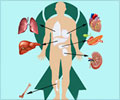Adult muscle stem cell tranplantation in mice showed to restore muscle damage in a research at Stanford University
Stanford University researchers have for the first time shown that a single adult stem cell can self-renew in a mammal.
Presenting their work at the ongoing 48th annual meeting of the American Society for Cell Biology (ASCB) in San Fransisco, the researchers said that the transplanted adult stem cell and its differentiated descendants restored lost function to mice with hind limb muscle tissue damage.The researchers revealed that the adult stem cells they used in their study were isolated from a mixed population of satellite cells in the skeletal muscle of mice.
The skeletal adult muscle stem cells (MusSC), which live just under the membrane surrounding muscle fibres, normally respond to tissue damage by giving rise to progenitor cells that become myoblasts, fusing into myofibres to repair the tissue damage.
During the study, the researchers transplanted the MusSC into special immune-suppressed "nude" mice whose muscle satellite cells had been wiped out in a hind limb by irradiation.
According to them, the mice would only be able to repair injury if the transplanted MuSC "took".
Lead researchers Alessandra Sacco and Helen Blau said that they had genetically engineered the transplanted MusSC to express Pax7 and luciferase proteins, and consequently, every transplanted cell glowed under ultraviolet light and was easy to trace.
"To be able to detect the presence of the cells by bioluminescence was really a breakthrough. It taught us so much more. We could see how the cells were responding, and really monitor their dynamics," said Blau.
The researchers said that luminescent imaging and quantitative and kinetic analyses enabled them to track each transplanted stem cell as it rapidly proliferated and engrafted its progeny into the irradiated muscle tissue.
They later injured the regenerated tissue to set off massive waves of muscle cell growth and repair, and subsequently showed that the MuSC and descendents rescued the second animal's lost muscle healing function.
Sacco and Blau isolated the luciferase-glowing muscle stem cells from the transplanted animal, and cloned them in the lab.
They observed that just like original MuSC, the cloned copies were intact and capable of self-renewal.
"We are thrilled with the results. It's been known that these satellite cells are crucial for the regeneration of muscle tissue, but this is the first demonstration of self-renewal of a single cell," says Sacco.
The researchers believe that the ability to isolate and transplant skeletal adult muscle stems cells may significantly improve treatments for a variety of muscle wasting diseases such as muscular dystrophy.
According to them, this may also open the door for potential treatments for severe muscle injuries or loss of function from aging and disuse.
In other experiments, the team transplanted between 10 and 500 luciferase-tagged MuSC into the leg muscles of mice, and again found them to proliferated and engrafted, forming new myofibres and fusing with injured fibres.
Unlike tumour cells, the transplanted stem cells achieved homeostasis, growing to a stable, constant level and ceasing replication.
Having observed that the transplanted stem cells proliferated and fully restored the animal's lost function, the researchers recovered new stem cells from the transplant with full stem cell potency, meeting the final "gold standard" test for adult multipotent stem cells.
Source-ANI
PRI/SK












